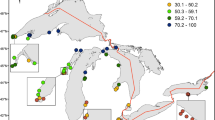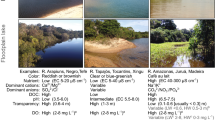Abstract
Tidal freshwater wetlands and associated open water are a distinctive type of estuarine ecosystem located upstream from tidal saline wetlands (salt marshes) and downstream from non-tidal freshwater wetlands (Figure 46.1). They are characterized by near freshwater conditions (average annual salinity of 0.5 ppt or below) except during periods of extended drought, but they also have a daily, lunar tidal fluctuation as a result of their position, typically at the upper end of the estuary. In a classification system based on salinity, these wetlands lie between the oligohaline zone and non-tidal freshwater.
Access this chapter
Tax calculation will be finalised at checkout
Purchases are for personal use only
Preview
Unable to display preview. Download preview PDF.
Similar content being viewed by others
References
Dahlberg, M.D. (1972) An ecological study of Georgia coastal fishes. Fish. Bull., 70, 323–53
Deaton, L.E. and Greenberg, M.J. (1986) There is no horohalinicum. Estuaries, 9, 20–30
Diaz, R.J. (1977) The effects of pollution on benthic communities of the tidal James River, Virginia. PhD dissertation, University of Virginia, Charlottesville. 149 pp.
Gunter, G. and Shell, W.E. (1958) A study of an estuarine area with water-level control in the Louisiana marsh. Proc. La. Acad. Sci., 21, 5–34
Hastings, R.W. and Good R.E. (1977) Population analysis of the fishes of a freshwater tidal tributary of the lower Delaware River. Bull. N.J. Acad. Sci., 22, 13–20
Holder, D.R. (1982) A fisheries survey of the Altamaha River. Proj. No. F-29–8. Georgia Dept. Nat. Resour., Game Fish Division, 49 pp
Hornsby, J.H. (1982) A fisheries survey of the Savannah River. Project No. F-30–9. Georgia Dept. Nat. Resour. Game Fish Division, 23 pp.
Khlebovich, V.V. (1969) Aspects of animal evolution related to critical salinity and the internal state. Mar. Biol., 2, 338–45
Kirk, W.L. (1974) Macroinvertebrates. In L.D. Jensen (ed.), Environmental responses to thermal discharges from the Chesterfield station, James River, Virginia. Cooling water studies for electric power research institute. Research Project RP-49
Lewis, R.R., Gilmore, R.G., Crewz, D.W. and Odum, W.E. (1986) Mangrove habitat and fishery resources of Florida. In W. Seaman (ed.), Florida aquatic habitat and fishery resources. Fla. Chapt. Am. Fish. Soc. Kissimee, Fla. pp. 281–336
Lippson, A.J., Haire, M.S., Holland, A.F., Jacobs, F., Jensen, J., Moran-Johnson, R.L., Polgar, T.T. and Richkus, W.A. (1979) Environmental atlas of the Potomac Estuary. Williams and Heintz Map Corp., Washington, DC, 280 pp.
Massman, W.H., Ladd, E.C. and McCutcheon, H.N. (1952) A biological survey of the Rappahannock River, Va. Part I. Va. Fish. Lab. Spec. Sci. Rep., 6, 112 pp.
Mclvor, C.C., Rozas, L.P. and Odum, W.E. (in press) Use of the marsh surface by fishes in tidal freshwater wetlands. Proc. Conf. Freshwater Wetlands. Savannah River Ecol. Lab. Publication
Odum, W.E., Smith, T.J., Hoover, J.K. and Mclvor, C.C. (1984) The ecology of tidal freshwater marshes of the United States east coast: a community profile. US Fish Wildl. Serv., FWS/ OBS83/17, 177 pp.
Perlmutter, A., Schmidt, E.E. and Leff, E. (1967) Distribution and abundance of fish along the shores of the lower Hudson River during the summer of 1965. NY Fish Game J., 14, 47–75
Powell, J.C. (1977) The diel distribution and relative abundance of adult and larval fishes in a freshwater tidal creek. MS thesis. George Mason University, Fairfax, Va. 85 pp.
Remane, A. (1934) Die Brackwasser fauna. Verh. Dtsch. Ges., 36, 34–74
Rogers, S.G., Targett, T.E. and Van Sant, S.B. (1984) Fish-nursery use in Georgia salt-marsh estuaries: the influence of springtime freshwater conditions. Trans. Am. Fish. Soc., 113, 595–606
Rounsefell, G.A. (1964) Preconstruction study of the fisheries of the estuarine areas traversed by the Mississippi River-Gulf Outlet project. Fish. Bull., 63, 373–93
Rozas, L.P. and Hackney, C.T. (1983) The importance of oligohaline estuarine wetland habitats to fisheries resources. Wetlands, 3, 77–89
Rozas, L.P. and Hackney, C.T. (1984) Use of oligohaline marshes by fishes and macrofaunal crustaceans in North Carolina. Estuaries, 7, 213–24
Virginia Institute of Marine Science (1978) Habitat development field investigations, Windmill Point marsh development site, James River, Virginia. Appendix D: environmental impacts of marsh development with dredged materials. Prepared for the Army Corps of Engineers, Vicksburg, Miss. Contract no. DACW3976-C-0040
Rights and permissions
Copyright information
© 1988 Donal D. Hook
About this chapter
Cite this chapter
Odum, W.E., Rozas, L.P., McIvor, C.C. (1988). A Comparison of Fish and Invertebrate Community Composition in Tidal Freshwater and Oligohaline Marsh Systems. In: The Ecology and Management of Wetlands. Springer, New York, NY. https://doi.org/10.1007/978-1-4684-8378-9_46
Download citation
DOI: https://doi.org/10.1007/978-1-4684-8378-9_46
Publisher Name: Springer, New York, NY
Print ISBN: 978-1-4684-8380-2
Online ISBN: 978-1-4684-8378-9
eBook Packages: Springer Book Archive




